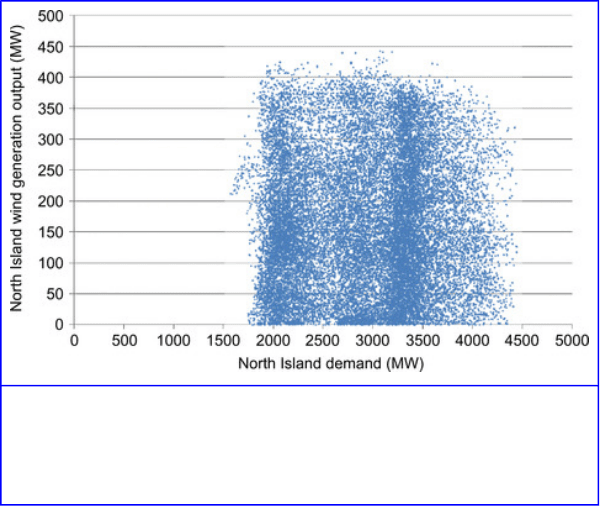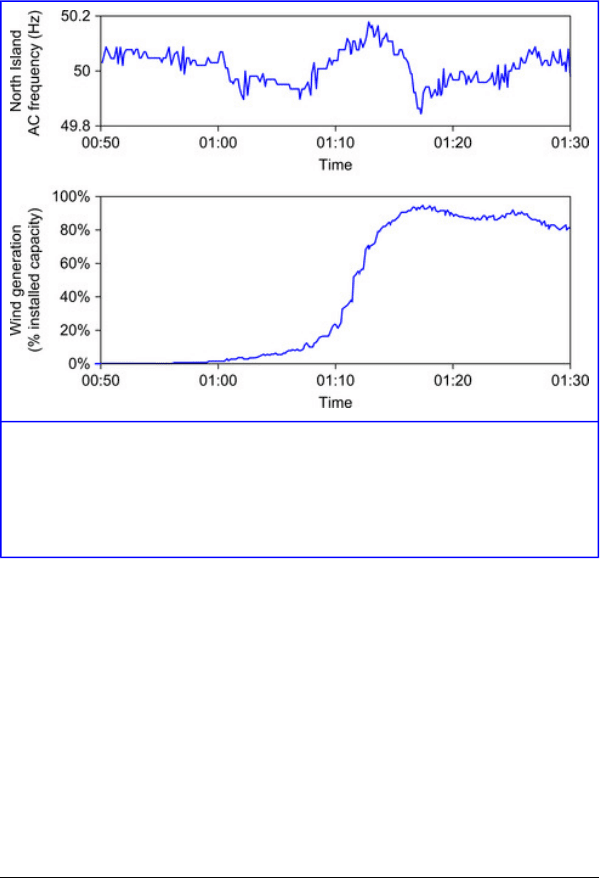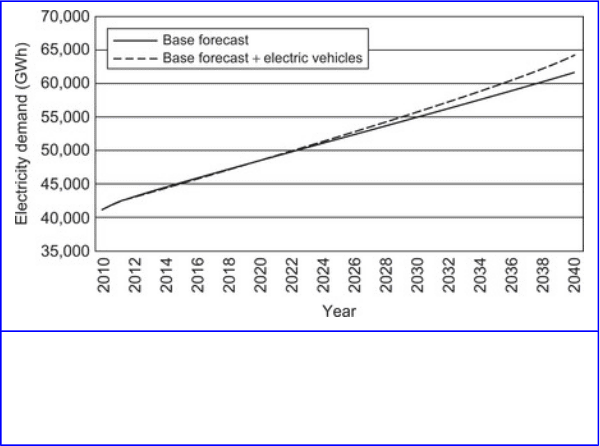Sioshansi F.P. Smart Grid: Integrating Renewable, Distributed & Efficient Energy
Подождите немного. Документ загружается.


Integration of Large-Scale Wind Generation in New
Zealand
New Zealand is regarded as having one of the best wind
resources of any country in the world [5]. The country lies
across prevailing westerly winds sometimes referred to as the
“Roaring Forties.” Wind flow in some locations is almost
continuous and of relatively high speed, which makes these
areas well suited to wind energy development. This is
exemplified by West Wind, which is a 143-MW wind
generation station near Wellington commissioned in 2009. It
is one of the best performing wind generation installations in
the world with a capacity factor
4
around 47%. The New
Zealand average is approximately 40%, while the
international average is ~30%.
5
4
Capacity factor is the amount of energy generated over a period as a
percentage of the energy that could have been generated if the power
station had been running at its full output for the whole time.
5
Source: http://www.windenergy.org nz/nz-wind-farms/
operating-wind-farms/project-west-wind.
Wind generation on the New Zealand power system had an
installed capacity of around 530 MW in early 2011.
6
There
are further wind generation projects comprising an installed
capacity of over 2,400 MW that have already gained
regulatory consent or are in the consenting process. During
high wind conditions, wind generation could exceed the
current demand during some off-peak hours and could equal
871

~40% of the peak demand. Wind generation, as seen in Figure
18.2, in New Zealand tends not to correlate well with load.
6
New Zealand Wind Energy Association; http://www.windenergy.org.nz.
Figure 18.2
Correlation between wind generation and demand in the North Island (May
2010 to April 2011).
In 2008, the System Operator part of Transpower published a
study on the impacts of large-scale wind generation on the
power system operation and electricity market operation in
New Zealand [6]. The most immediate issue was found to be
the effect of unpredictability of wind generation output on
pre-dispatch processes. Based on an estimate of future wind
generation forecast errors, it was found that these soon would
dominate the load forecast error in the scheduling and
dispatch processes [7]. At the anticipated level of wind
872
generation, which is around 2,000 MW in 10 years, large
forecast errors would be common. Wind generation forecasts
six hours ahead of dispatch might have an error equivalent to
10–30% of island demand on a daily basis.
7
7
Garrad Hassan, Wind power variability and forecast accuracy in New
Zealand, 20 March 2007, Figures 4.8 to 4.10.
The variability of wind generation output during dispatch was
not found to be a major issue. The extent of the predicted
variability of anticipated wind generation penetration is
similar to the variability of demand [6]. There may be
increased requirements for frequency keeping and more
occurrences of generation re-dispatch but the effects are
manageable.
8
8
Large frequency fluctuations are already experienced in the New
Zealand power system, see discussion around Figure 18.9.
The probability and size of large sudden changes in aggregate
wind generation output are, however, areas of concern.
Operational experience with wind generation in New Zealand
is very limited. Large sudden changes of Manawatu wind
generation output have been observed to occur frequently;
9
for example, changes equal to 66% of installed wind capacity
over five minutes [7] as per Figure 18.3.
9
Most of the existing wind capacity is located in the Manawatu district in
the lower North Island region.
873

Figure 18.3
Observed wind generation output changes and frequency variations on
November 15, 2004.
Source: Adapted from Transpower [7]
A doubling of the amount of installed wind generation
capacity in the Manawatu region could result in large sudden
changes of a size equal to the largest generating unit on the
North Island power system. Sudden large changes in regional
wind generation output of 33% or greater of installed capacity
in the region are likely to occur around 20 times per year.
Such large changes over a short period have the potential to
cause significant power system frequency excursions.
Integration of Large Numbers of EVs in New Zealand
As in many other places around the world, EVs have been
looked upon as an option to meet objectives of reduced
874
carbon emissions and lowering the dependency on imported
fossil fuels. The 2007 New Zealand Energy Strategy
especially pointed out EVs as one option to meet those
objectives [1]. Only a few studies on how large numbers of
EVs can be integrated into the New Zealand power system
have been published though [8].
One important variable when assessing the effects of
large-scale EV uptake in New Zealand is when the vehicles
would appear. There were around 2.6 million registered
passenger cars in New Zealand in 2010,
10
a number that is
forecasted to grow to 3.2 million by 2040 [8]. Around
200,000 cars are brought into New Zealand each year.
10
New Zealand Ministry of Transport: http://www.transport.govt.nz/
research/newzealandvehiclefleetstatistics.
As an extreme case, even if all imported 200,000 cars per
year from, say, 2016 were EVs, it would still take more than a
decade for EVs to make up the greater part of the passenger
vehicle fleet. The actual uptake is expected to be much less
initially, so it is more likely to take at least two decades from
now before more than 50% of the light vehicle fleet is
electric.
Such an uptake will result in about a 12% increase in the
electricity demand compared with the total demand in 2008.
11
A 12% increase in electricity generation over a decade or
two corresponds roughly to an average annual energy increase
of 1% per year. During the 1990s, the annual energy demand
growth was around 2%, but it has been growing at a slower
rate in the last decade. An additional 1% increase on top of
the normal demand increase is not going to pose major
challenges to meeting the energy requirements of EVs over
875

the coming decades. This is especially the case as the few
actual projections that have been made (one example is
shown later in Figure 18.4) point towards an even slower
uptake.
11
Assuming 1.5 million electric cars, each traveling 40 km each day
requiring 1 kWh per 5 km traveled.
Figure 18.4
The demand forecasts from the 2008 Statement of Opportunities.
Source: Electricity Commission [9]
While the energy balance can be managed, the implications
for transmission and distribution planning depend on when
the energy is required and hence, what the impact on peak
demand will be. It critically depends on when EVs will be
charged. For example, if 500,000 EVs (~20% of the current
light vehicle fleet) were driven to their respective homes and
plugged in at or about 6.00 PM the load on the power system
could increase by 1.5 GW in approximately 30 minutes. This
876
represents an increase of more than 20% in peak demand over
today.
The Opportunity at Hand
New Zealand's installed wind capacity has around a 40% load
factor. In terms of energy only, the entire vehicle fleet of
approximately 3 million vehicles could be powered
completely by wind power assuming they were EVs if most
of the wind projects currently in the consenting process are
built. However, infrastructure and economic considerations
will likely limit the uptake of wind generation and EVs to
well below these figures:
• Large investment in transmission and distribution
networks may need to be brought forward to meet the
demand from electric vehicles.
• The cost of frequency keeping will increase as the
variability of load and generation increases.
• The ability to accurately forecast wind generation and EV
charging will be critical to the way in which the technical
standards and market arrangements will need to change to
accommodate large-scale wind generation in New Zealand.
In cases where wind generation forecasting or EV charging
is uncertain, the variability will need to be managed during
dispatch. Increased variability in dispatch will increase the
costs of electricity in New Zealand as additional resources
are procured to manage that variability.
There is an opportunity to reduce these costs. Time-of-use
pricing signals will provide incentives for owners of EVs to
charge their vehicles at times when electricity costs are low
877

and the grid is unconstrained. This topic is further
investigated below.
There is another opportunity in New Zealand, and elsewhere,
to reduce the effects of the variability of wind generation
output and EV charging. This is through dynamic demand
control, a technology that has seen significant development in
New Zealand since the 1980s. This technology has the
potential to significantly reduce the costs of operating the grid
as well as neutralizing the variability of wind generation
output and EV charging. This technology and how it can be
used are described in the section “Integration Costs of Wind
and Electric Vehicles in New Zealand.”
Integration Costs of Wind and Electric Vehicles in
New Zealand
This section is based on a detailed computational study
undertaken to assess how wind power and EVs may interact
in partnership as the title of the chapter suggests. Chapter 19
looks at a similar study in the French grid. This chapter
considers how overall integration costs for large-scale wind
and EV integration in an island power system can be reduced,
and Chapter 19 provides insight into a new way of modeling
the effect of EVs on market prices in the French market.
Assumptions
The analysis was based on the Electricity Commission's 2008
Statement of Opportunities [9], which provided an outlook on
the New Zealand electricity future out to 2040. It featured
five market development scenarios of which two assumed an
uptake of EVs. These two, known as the “Sustainable Path”
878
and “Demand Side Participation,” scenarios form the basis of
the following analysis.
Figure 18.4 illustrates how much the demand forecasts
increased above the base forecast for these two scenarios. The
forecasted demand for the EVs (i.e., the difference between
the full and the dotted line above) is 280 GWh in 2025,
growing to 2,660 GWh in 2040 [9]. For 2040, this equals
approximately 4% of the total forecasted electricity
consumption that year.
The forecast is based on EV uptake rates from the Ministry of
Transport's vehicle fleet model and assumptions about the
travel distance per car per day. It is assumed that EVs are first
introduced in 2016 and reach a penetration of 35% by 2040.
For the latter year, this corresponds to a situation where 50%
of all new car sales are EVs. Overall, the EV forecast used
here is consistent with a number of other studies for EV
uptake in New Zealand [1], [5] and [8].
The two Electricity Commission scenarios differed
considerably with regard to future carbon price assumptions
and led to very different wind penetration levels. To
supplement these, a third scenario with even higher wind
penetration has been analyzed as well in this study. In
summary, the three scenarios are:
• High wind scenario: ~25% penetration
12
12
This is measured as wind generation as percent of annual electricity
consumption.
• Medium wind scenario: ~15% penetration (Sustainable
Path scenario)
879

• Low wind scenario: ~5% penetration (Demand Side
Participation)
Modeling
The analysis was undertaken using the PLEXOS modeling
tool.
13
PLEXOS can mimic the Scheduling, Pricing, and
Dispatching (SPD) algorithm used as the dispatch engine in
the New Zealand Electricity Market, including the
co-optimization of energy and instantaneous reserves.
13
Information can be obtained from http://www.energyexemplar.com.
For the analysis, a nodal model of the transmission system
was used modeling approximately 170 nodes and the
transmission flows in between. The focus has been on the
year 2040, which was modeled using hourly time resolution.
The fine time resolution was considered essential to capturing
the interaction between varying wind power and EV charging.
Before that year, the impacts of EVs would be lesser given
the relatively slow turnover of the vehicle fleet.
The modeling of both wind power and EV charging used the
approach of Rasmussen and Windolf [10]. Historical hourly
wind profiles for different locations were used, which ensured
that realistic wind variability and geographical correlation
were captured. The annual EV demand was converted into a
daily energy requirement, which was calculated for each of
the 18 regions in the model.
New in this chapter, however, is an analysis of the impacts of
that daily energy requirement being recharged in different
880
